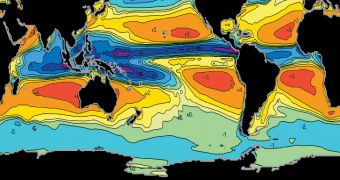The ultimate goal of the SAC-D/Aquarius mission will be to provide climate researchers with relevant data for developing advanced model describing the Earth's atmosphere. The way it will accomplish this is by analyzing ocean salinity.
Despite its simple molecular structure, salt is extremely critical to a large number of processes going on inside the world's oceans. In fact, some of the most important processes would be impossible without it.
What the Aquarius instrument on the SAC-D satellite will aim to discover is the exact extent of its influence. The mission is scheduled to launch this month, and it represents a collaboration between NASA and Argentina's Comisión Nacional de Actividades Espaciales (CONAE).
The Argentinian space agency was in charge of building the Satélite de Aplicaciones Científicas (SAC)-D spacecraft, while NASA, through the Jet Propulsion Laboratory (JPL) and the Goddard Space Flight Center (GSFC), managed to design and construction of the main science payload, Aquarius.
While climate scientists have access to a wealth of data on many factors affecting the world's oceans, they have relatively few readings on ocean salinity, a measure describing the concentration of dissolved sea salt at the surface of the world's ocean.
Yet these data are essential for climate models, seeing how the interactions between the ocean and the atmosphere produces weather events, heats up continents, and controls precipitation, global sea levels, ocean acidification and so on.
Ultimately, the goal is a better understanding of our planet's freshwater cycle, as in the paths it takes while being transferred between water, land and air. The SAC-D/Aquarius combo was designed specifically to solve this mystery.
“We ultimately want to predict climate change and have greater confidence in our predictions. Climate models are the only effective means we have to do so,” Seattle-based independent laboratory Earth & Space Research expert Gary Lagerloef says.
He is also the principal investigator of the Aquarius instrument. “But, a climate model's forecast skill is only as good as its ability to accurately represent modern-day observations,” the expert reveals.
“Aquarius, and successor missions based on it, will give us, over time, critical data that will be used by models that study how Earth's ocean and atmosphere interact, to see trends in climate. The advances this mission will enable make this an exciting time in climate research,” he adds.
Lagerloef concludes by saying that, even though sea salt only makes up 3.5 percent of the world's ocean, it is still one of the most important actors determining our planet's climate patterns.

 14 DAY TRIAL //
14 DAY TRIAL //